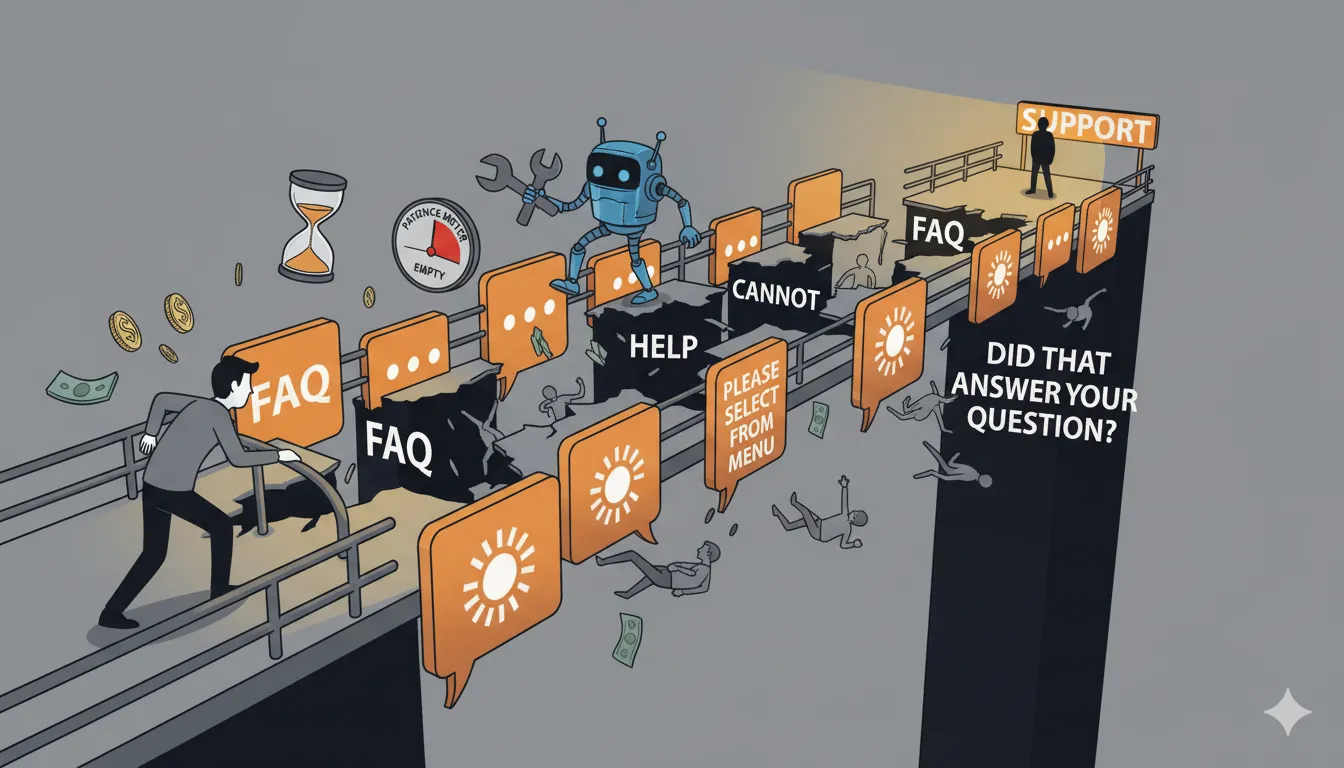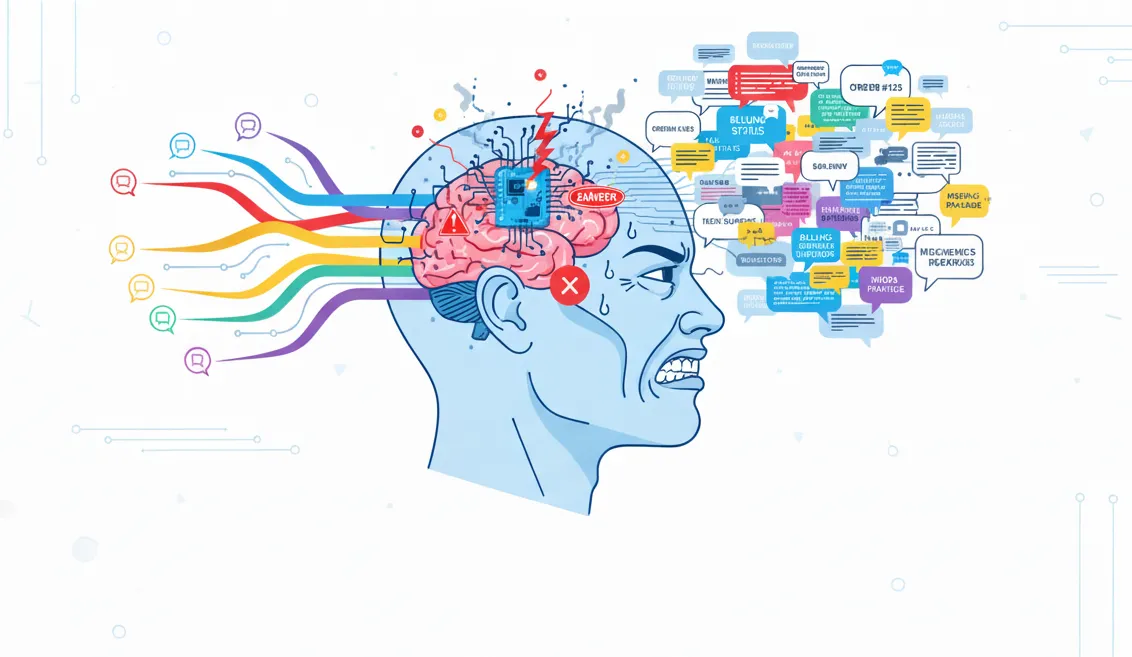When AI Customer Service Becomes a Weapon Against Customers: The Dark Pattern Everyone’s Experiencing
The frustration is real. And it’s by design.
A recent Reddit post captured what millions of customers are experiencing but struggling to articulate: AI customer service isn’t just bad—it feels deliberately obstructive.
“The AI purposely runs very slow to get you annoyed and frustrated so that you end up not even wanting to file your claim.”
This isn’t paranoia. It’s pattern recognition.
And the implications for businesses trying to build genuine customer relationships are critical.
The Problem: AI as Barrier, Not Bridge
What started as a promise to “improve customer experience through AI” has morphed into something darker: AI as a moat designed to keep customers away from actual support.
The tactics are familiar to anyone who’s tried to contact customer service recently:
Endless loops: AI chatbots that cycle through irrelevant options, never quite matching your actual problem
Deliberate friction: Slow response times that test your patience and willingness to persist
Hidden human access: “Contact agent” buttons buried or removed entirely, forcing you through automated mazes
Strategic deflection: AI programmed to close conversations or redirect to FAQs rather than escalate to humans
Response speed manipulation: Artificially slow AI responses that signal “this will take forever” to discourage you from continuing
The Reddit user’s observation about Amazon and Uber isn’t isolated. These patterns appear across industries—telecommunications, insurance, banking, retail—anywhere customer claims, refunds, or complaints cost companies money.
Why This Strategy Backfires Catastrophically
Companies implementing these “defensive AI” strategies believe they’re optimizing for efficiency and cost reduction.
They’re actually optimizing for customer rage and brand erosion.
The math they see:
- Each human support interaction costs $5-15
- AI can handle inquiries for $0.50-2
- Reduce human contact = massive savings
The math they’re missing:
- Customer lifetime value lost: $500-5,000+
- Negative word-of-mouth reach: 10-15 people per frustrated customer
- Social media amplification: One viral complaint reaches thousands
- Competitive vulnerability: Customers actively seeking alternatives
When we analyze actual data, businesses using AI to amplify humans (not replace them) achieve 28% conversion rates compared to 12% with AI alone or 18% with humans alone.
The companies weaponizing AI against customers are achieving the opposite: driving conversion rates down while acquisition costs skyrocket.
The Psychology of Deliberate Friction
There’s a term for this in UX design: dark patterns—interfaces designed to trick or manipulate users into actions against their interests.
What we’re seeing with AI customer service is a new category: exhaustion design.
The strategy relies on a simple calculation:
- If we make support access painful enough
- A percentage of customers will give up
- We avoid the cost of resolution
- And most won’t switch providers (switching is also painful)
This works short-term. It’s catastrophic long-term.
Why exhaustion design backfires:
1. You’re training customers to hate your brand
Every frustrating interaction creates negative associations. Even when customers eventually get help, the experience is tainted by the obstacle course they navigated to reach it.
2. You’re selecting for your most motivated (and angry) customers
The customers who persist through your AI maze aren’t giving up. They’re getting angrier. By the time they reach a human, they’re primed for conflict, negative reviews, and social media complaints.
3. You’re creating viral negative content
Reddit posts, TikTok rants, Twitter threads about terrible customer service spread fast. One frustrated customer reaches thousands of potential customers who now see your brand as adversarial.
4. You’re vulnerable to disruption
The moment a competitor offers genuinely helpful AI + human support, you’ve created their differentiation strategy. “We actually help you talk to humans” becomes a competitive advantage you handed them.
The Amazon and Uber Example: Death by a Thousand Cuts
The Reddit post specifically called out Amazon and Uber. These aren’t random targets.
Amazon’s evolution:
Early Amazon: Legendary customer service, easy returns, “customer obsession”
Current Amazon: Increasingly difficult to reach humans, return windows narrowing, AI gatekeeping access
The shift is noticeable. And customers notice.
Uber’s worse trajectory:
Uber built a platform where both drivers and passengers struggle to reach support. Issues that should take 2 minutes require 20+ minutes of navigating unhelpful menus.
The result? Both customers and drivers feel abandoned by the platform. That’s not a sustainable marketplace model.
What Actually Works: The AI + Human Hybrid Model
The data from analyzing 50,000+ customer conversations is clear: AI alone achieves 12% conversion, humans alone achieve 18%, but AI + human hybrid achieves 28% conversion—2-3x better than either alone.
The winning approach uses AI to amplify humans, not replace them:
AI handles:
- Initial triage and intent detection
- Gathering relevant information before human handoff
- Routing to the right specialist immediately
- Providing instant answers to simple, factual questions
- Following up automatically after human interactions
Humans handle:
- Complex problems requiring judgment
- Emotional situations requiring empathy
- High-value customer interactions
- Situations where trust is critical
- Anything involving refunds, claims, or disputes
The critical difference: The AI is designed to GET customers to humans faster, not keep them away.
Real Examples of Getting It Right
Not every company is weaponizing AI against customers. Some are doing the opposite.
Zappos approach:
Known for empowering support agents to spend whatever time necessary to help customers. They use AI for routing and information gathering, but humans handle the actual support. Result: Legendary customer loyalty.
Apple Support evolution:
While Apple’s automated systems handle simple tasks, they’ve maintained relatively easy access to human specialists. Their AI identifies complex issues and escalates quickly rather than forcing customers through endless loops.
Luxury retail live shopping:
Brands using conversational commerce platforms report 28% conversion rates compared to 2% traditional ecommerce average—not because products are different, but because uncertainty is eliminated before it becomes abandonment.
When customers can immediately ask questions and get human responses, conversion skyrockets.
The Three Tests for Ethical AI Customer Service
If you’re implementing AI in customer service, ask these three questions:
1. Time-to-Human Test
Can a customer reach a human agent in under 2 minutes if they need one?
If no: You’re using AI as a barrier, not a tool.
2. Escalation Design Test
Is your AI programmed to escalate complex issues to humans proactively, or is it programmed to deflect as long as possible?
If deflect: You’re optimizing for the wrong metric.
3. Friction Audit Test
Would you tolerate your own customer service experience if you had a real problem?
If no: Your customers won’t either.
The Cost of Getting This Wrong
Let’s make this concrete with actual numbers.
Scenario: Mid-size ecommerce company, 500,000 annual customers
Current “defensive AI” approach:
- 50,000 customers attempt support annually
- 30% give up due to friction (15,000 customers)
- Average customer LTV: $800
- Lost LTV from frustrated customers: $12 million
- Negative word-of-mouth impact: Unmeasurable but substantial
- Support cost savings: $750,000
Net result: Saved $750K in support costs, lost $12M+ in customer value
This doesn’t include:
- Acquisition cost waste (paid to acquire customers who leave frustrated)
- Competitive vulnerability (competitors marketing “we actually help you”)
- Employee morale impact (support staff dealing with enraged customers)
- Brand reputation damage
What to Do Instead: The Proactive AI Model
The alternative isn’t eliminating AI. It’s using AI properly.
Design AI to:
Accelerate human connection, not prevent it
- “I see this is complex, let me connect you to Sarah who specializes in this”
- Not: “I cannot connect you to an agent for this issue”
Reduce customer effort, not increase it
- Gather information before handoff so customers don’t repeat themselves
- Not: Make customers navigate 6 menus to reach the same dead end
Empower customers with choice
- “Would you like AI help or prefer to speak with an agent directly?”
- Not: Force everyone through the AI maze regardless of complexity
Be transparent about capabilities
- “I can help with X, Y, Z, but for issues like yours, an agent would be better”
- Not: Pretend to be helpful while providing useless responses
Optimize for resolution, not deflection
- Measure: Customer issue resolved? Customer satisfaction? Time to resolution?
- Not just: How many conversations did we avoid escalating?
The Broader Implications for Conversational Commerce
This isn’t just about customer service. It’s about the entire future of how businesses interact with customers.
Live shopping and conversational commerce are growing toward $4 trillion by 2025 specifically because they eliminate the friction that traditional ecommerce creates.
When customers can ask questions in real-time and get genuine helpful responses—not defensive deflection—conversion rates increase 10-15x.
The same principle applies to support:
Defensive AI approach:
- Treats customers as costs to minimize
- Optimizes for fewer interactions
- Results: Lower costs short-term, customer exodus long-term
Conversational commerce approach:
- Treats customers as relationships to nurture
- Optimizes for helpful interactions
- Results: Higher costs per interaction, dramatically higher LTV
The Trust Equation
Ultimately, this comes down to trust.
Every business decision signals something about how you view customers:
Defensive AI signals: “We see you as a cost center. We don’t trust you have legitimate issues. We’ll make you prove you deserve human help.”
Helpful AI + Human signals: “We see you as a valued relationship. We trust when you need help, you need help. We’ll make it easy to get the assistance you need.”
Customers read these signals instantly.
And they respond accordingly—with loyalty or exit.
What This Means for Your Business
If you’re implementing AI in customer-facing roles:
Ask yourself honestly:
Are we using AI to make it easier for customers to get help?
Or are we using AI to make it harder for customers to cost us money?
The first builds businesses.
The second destroys them.
The Reddit user’s rage isn’t an edge case.
It’s the canary in the coal mine.
When customers start actively saying “FUCK THESE COMPANIES” in public forums, you’re not dealing with a customer service problem.
You’re dealing with an existential brand threat.
The solution isn’t less AI. It’s better AI.
AI that recognizes when humans are needed and gets out of the way.
AI that reduces friction instead of creating it.
AI that treats customer problems as opportunities to build relationships, not costs to avoid.
Because here’s the truth companies implementing defensive AI need to hear:
Your customers know what you’re doing.
They feel the deliberately slow responses.
They recognize the menu options designed to exhaust them.
They see through the “we cannot connect you to an agent” deflection.
And they’re not just frustrated.
They’re done.
The question is whether you’ll realize it before they are.
What are you seeing in your industry? Are companies using AI to help customers or deflect them? Drop your experiences in the comments.
At Immerss.live, we believe AI should amplify human connection, not replace it. Our conversational commerce platform uses AI to identify when customers need help and connect them with specialists instantly—because real relationships drive real results.



